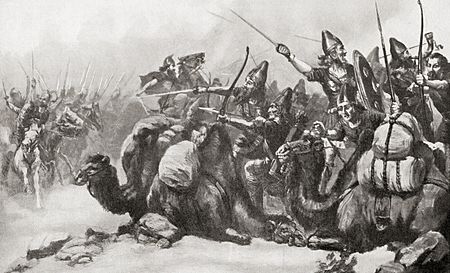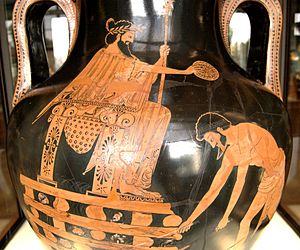Cyrus the Great facts for kids
Quick facts for kids Cyrus the Great𐎤𐎢𐎽𐎢𐏁 |
|
|---|---|
|
|

Cyrus the Great with a Hemhem crown, from a relief in the residence of Cyrus in Pasargadae
|
|
| King of Kings of the Achaemenid Empire | |
| Reign | 559–530 BC |
| Predecessor | Empire established |
| Successor | Cambyses II |
| King of Persia | |
| Reign | 559–530 BC |
| Predecessor | Cambyses I |
| Successor | Cambyses II |
| King of Media | |
| Reign | 549–530 BC |
| Predecessor | Astyages |
| Successor | Cambyses II |
| King of Lydia | |
| Reign | 547–530 BC |
| Predecessor | Croesus |
| Successor | Cambyses II |
| King of Babylon | |
| Reign | 539–530 BC |
| Predecessor | Nabonidus |
| Successor | Cambyses II |
| Born | c. 600 BC Anshan, Persis (present-day Fars Province, Iran) |
| Died | 4 December 530 BC (aged 70) Syr Darya, Central Asia |
| Burial | Pasargadae |
| Consort | Cassandane, Amytis of Media |
| Issue |
|
| House | Teispid |
| Father | Cambyses I |
| Mother | Mandane of Media |
Cyrus II of Persia (c. 600–530 BC; Old Persian: 𐎤𐎢𐎽𐎢𐏁 Kūruš), commonly known as Cyrus the Great, was the founder of the Achaemenid Empire, the first Persian empire. Under his rule, the empire embraced all of the previous civilized states of the ancient Near East, expanded vastly and eventually conquered most of Western Asia and much of Central Asia. Spanning from the Mediterranean Sea and Hellespont in the west to the Indus River in the east, the empire created by Cyrus was the largest the world had yet seen. At its maximum extent under his successors, the Achaemenid Empire stretched from parts of the Balkans (Eastern Bulgaria–Paeonia and Thrace–Macedonia) and Southeast Europe proper in the west to the Indus Valley in the east.
The reign of Cyrus lasted about thirty years; his empire took root with his conquests of the Median Empire, then the Lydian Empire and eventually the Neo-Babylonian Empire. He also led an expedition into Central Asia, which resulted in major campaigns that were described as having brought "into subjection every nation without exception". Cyrus did not venture into Egypt, and was alleged to have died in battle while fighting the Massagetae, an ancient Eastern Iranian nomadic tribal confederation, along the Syr Darya in December 530 BC. However, Xenophon claimed that Cyrus did not die in battle and returned to the Achaemenid ceremonial capital of Persepolis again. He was succeeded by his son, Cambyses II, who managed to conquer Egypt, Nubia and Cyrenaica during his short rule.
Known as Cyrus the Elder (Greek: Κῦρος ὁ Πρεσβύτερος, translit. Kŷros ho Presbýteros) to the Greeks, he was well-known for having respected the customs and religions of the lands he conquered. He was important in developing the system of a central administration at Pasargadae governing satraps in the empire's border regions, which worked very effectively and profitably for both rulers and subjects. The Edict of Restoration, a proclamation attested by a cylinder seal in which Cyrus authorized and encouraged the return of the Israelites to the Land of Israel following his conquest of the Neo-Babylonian Empire, is described in the Bible and likewise left a lasting legacy on the Jewish religion due to his role in ending the Babylonian captivity and facilitating the Jewish return to Zion. According to Isaiah 45:1 of the Hebrew Bible, God anointed Cyrus for this task, even referring to him as a messiah (lit. anointed one); Cyrus is the only non-Jewish figure in the Bible to be revered in this capacity.
Cyrus is also recognized for his achievements in human rights, politics, and military strategy, as well as his influence on both Eastern and Western civilizations. The Achaemenid influence in the ancient world would eventually extend as far as Athens, where upper-class Athenians adopted aspects of the culture of the ruling class of Achaemenid Persia as their own. Having originated from Persis, roughly corresponding to the modern-day Fars Province of Iran, Cyrus has played a crucial role in defining the national identity of modern Iran. He remains a cult figure amongst modern Iranians, with his tomb serving as a spot of reverence for millions of people. In the 1970s, the last Shah of Iran, Mohammad Reza Pahlavi, identified Cyrus' famous proclamation inscribed onto the Cyrus Cylinder as the oldest-known declaration of human rights, and the Cylinder has since been popularized as such. This view has been criticized by some Western historians as a misunderstanding of the Cylinder's generic nature as a traditional statement that new monarchs make at the beginning of their reign.
Contents
Early life
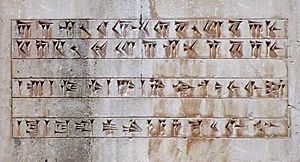
Cyrus was born to Cambyses I, King of Anshan, and Mandane, daughter of Astyages, King of Media, during the period of 600–599 BC.
By his own account, generally believed now to be accurate, Cyrus was preceded as king by his father Cambyses I, grandfather Cyrus I, and great-grandfather Teispes. Cyrus married Cassandane who was an Achaemenian and the daughter of Pharnaspes who bore him two sons, Cambyses II and Bardiya along with three daughters, Atossa, Artystone, and Roxane. Cyrus and Cassandane were known to love each other very much – Cassandane said that she found it more bitter to leave Cyrus than to depart her life. After her death, Cyrus insisted on public mourning throughout the kingdom. The Nabonidus Chronicle states that Babylonia mourned Cassandane for six days (identified as 21–26 March 538 BC). After his father's death, Cyrus inherited the Persian throne at Pasargadae, which was a vassal of Astyages. The Greek historian Strabo has said that Cyrus was originally named Agradates by his step-parents. It is possible that, when reuniting with his original family, following the naming customs, Cyrus's father, Cambyses I, named him Cyrus after his grandfather, who was Cyrus I. There is also an account by Strabo that claimed Agradates adopted the name Cyrus after the Cyrus river near Pasargadae.
Rise and military campaigns
Median Empire
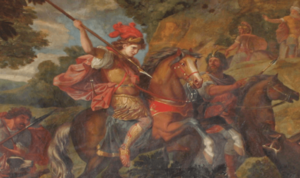
Cyrus the Great succeeded to the throne in 559 BC following his father's death; however, Cyrus was not yet an independent ruler. Like his predecessors, Cyrus had to recognize Median overlordship. Astyages, last king of the Median Empire and Cyrus' grandfather, may have ruled over the majority of the Ancient Near East, from the Lydian frontier in the west to the Parthians and Persians in the east.
According to the Nabonidus Chronicle, Astyages launched an attack against Cyrus, "king of Ansan". According to the historian Herodotus, it is known that Astyages placed Harpagus in command of the Median army to conquer Cyrus. However, Harpagus contacted Cyrus and encouraged his revolt against Media, before eventually defecting along with several of the nobility and a portion of the army. This mutiny is confirmed by the Nabonidus Chronicle. The Chronicle suggests that the hostilities lasted for at least three years (553–550), and the final battle resulted in the capture of Ecbatana. This was described in the paragraph that preceded the entry for Nabonidus' year 7, which detailed Cyrus' victory and the capture of his grandfather. According to the historians Herodotus and Ctesias, Cyrus spared the life of Astyages and married his daughter, Amytis. This marriage pacified several vassals, including the Bactrians, Parthians, and Saka. Herodotus notes that Cyrus also subdued and incorporated Sogdia into the empire during his military campaigns of 546–539 BC.
With Astyages out of power, all of his vassals (including many of Cyrus's relatives) were now under his command. His uncle Arsames, who had been the king of the city-state of Parsa under the Medes, therefore would have had to give up his throne. However, this transfer of power within the family seems to have been smooth, and it is likely that Arsames was still the nominal governor of Parsa under Cyrus's authority—more a Prince or a Grand Duke than a King. His son, Hystaspes, who was also Cyrus's second cousin, was then made satrap of Parthia and Phrygia. Cyrus the Great thus united the twin Achaemenid kingdoms of Parsa and Anshan into Persia proper. Arsames lived to see his grandson become Darius the Great, Shahanshah of Persia, after the deaths of both of Cyrus's sons. Cyrus's conquest of Media was merely the start of his wars.
Lydian Empire and Asia Minor
The exact dates of the Lydian conquest are unknown, but it must have taken place between Cyrus's overthrow of the Median kingdom (550 BC) and his conquest of Babylon (539 BC). It was common in the past to give 547 BC as the year of the conquest due to some interpretations of the Nabonidus Chronicle, but this position is currently not much held. The Lydians first attacked the Achaemenid Empire's city of Pteria in Cappadocia. Croesus besieged and captured the city enslaving its inhabitants. Meanwhile, the Persians invited the citizens of Ionia who were part of the Lydian kingdom to revolt against their ruler. The offer was rebuffed, and thus Cyrus levied an army and marched against the Lydians, increasing his numbers while passing through nations in his way. The Battle of Pteria was effectively a stalemate, with both sides suffering heavy casualties by nightfall. Croesus retreated to Sardis the following morning.
While in Sardis, Croesus sent out requests for his allies to send aid to Lydia. However, near the end of the winter, before the allies could unite, Cyrus the Great pushed the war into Lydian territory and besieged Croesus in his capital, Sardis. Shortly before the final Battle of Thymbra between the two rulers, Harpagus advised Cyrus the Great to place his dromedaries in front of his warriors; the Lydian horses, not used to the dromedaries' smell, would be very afraid. The strategy worked; the Lydian cavalry was routed. Cyrus defeated and captured Croesus. Cyrus occupied the capital at Sardis, conquering the Lydian kingdom in 546 BC. According to Herodotus, Cyrus the Great spared Croesus's life and kept him as an advisor, but this account conflicts with some translations of the contemporary Nabonidus Chronicle (the King who was himself subdued by Cyrus the Great after conquest of Babylonia), which interpret that the king of Lydia was slain.
Before returning to the capital, Commagene was incorporated into Persia in 546 BCE. Later, a Lydian named Pactyas was entrusted by Cyrus the Great to send Croesus's treasury to Persia. However, soon after Cyrus's departure, Pactyas hired mercenaries and caused an uprising in Sardis, revolting against the Persian satrap of Lydia, Tabalus. With recommendations from Croesus that he should turn the minds of the Lydian people to luxury, Cyrus sent Mazares, one of his commanders, to subdue the insurrection but demanded that Pactyas be returned alive. Upon Mazares's arrival, Pactyas fled to Ionia, where he had hired more mercenaries. Mazares marched his troops into the Greek country and subdued the cities of Magnesia and Priene. The end of Pactyas is unknown, but after capture, he was probably sent to Cyrus and put to death after a succession of tortures.
Mazares continued the conquest of Asia Minor but died of unknown causes during his campaign in Ionia. Cyrus sent Harpagus to complete Mazares's conquest of Asia Minor. Harpagus captured Lycia, Cilicia and Phoenicia, using the technique of building earthworks to breach the walls of besieged cities, a method unknown to the Greeks. He ended his conquest of the area in 542 BC and returned to Persia.
Eastern Campaigns
After the conquest of Lydia, Cyrus campaigned at the east around 545 BC to 540 BC. Cyrus first tried to campaign against Gedrosia, however was decisively defeated and had to leave the land. The land of Gedrosia was most likely under the reign of Darius I. After the failed attempt in Gedrosia, Cyrus attacked in the regions of Bactria, Archosia, Sogdia,Saka, Chorasmia, Margiana and other provinces in the east. In 533 BC, Cyrus the Great crossed the Hindu Kush mountains and collected tribute from the Indus cities. Thus, Cyrus probably had vassalage in India. Cyrus then returned to camp near Babylon due to unrest in Babylon.
Neo-Babylonian Empire
By the year 540 BC, Cyrus captured Elam (Susiana) and its capital, Susa. The Nabonidus Chronicle records that, prior to the battle(s), Nabonidus had ordered cult statues from outlying Babylonian cities to be brought into the capital, suggesting that the conflict had begun possibly in the winter of 540 BC. Near the beginning of October 539 BC, Cyrus fought the Battle of Opis in or near the strategic riverside city of Opis on the Tigris, north of Babylon. The Babylonian army was routed, and on 10 October, Sippar was seized without a battle, with little to no resistance from the populace. It is probable that Cyrus engaged in negotiations with the Babylonian generals to obtain a compromise on their part and therefore avoid an armed confrontation. Nabonidus, who had retreated to Sippar following his defeat at Opis, fled to Borsippa.
Two days later, on 12 October (proleptic Gregorian calendar), Gubaru's troops entered Babylon, again without any resistance from the Babylonian armies, and detained Nabonidus. Herodotus explains that to accomplish this feat, the Persians, using a basin dug earlier by the Babylonian queen Nitokris to protect Babylon against Median attacks, diverted the Euphrates river into a canal so that the water level dropped "to the height of the middle of a man's thigh", which allowed the invading forces to march directly through the river bed to enter at night. Shortly thereafter, Nabonidus returned from Borsippa and surrendered to Cyrus. On 29 October, Cyrus himself entered the city of Babylon.
Prior to Cyrus's invasion of Babylon, the Neo-Babylonian Empire had conquered many kingdoms. In addition to Babylonia itself, Cyrus probably incorporated its subnational entities into his Empire, including Syria, Judea, and Arabia Petraea, although there is no direct evidence of this fact.
After taking Babylon, Cyrus the Great proclaimed himself "king of Babylon, king of Sumer and Akkad, king of the four corners of the world" in the famous Cyrus Cylinder, an inscription deposited in the foundations of the Esagila temple dedicated to the chief Babylonian god, Marduk. The text of the cylinder denounces Nabonidus as impious and portrays the victorious Cyrus pleasing the god Marduk. It describes how Cyrus had improved the lives of the citizens of Babylonia, repatriated displaced peoples, and restored temples and cult sanctuaries. Although some have asserted that the cylinder represents a form of human rights charter, historians generally portray it in the context of a long-standing Mesopotamian tradition of new rulers beginning their reigns with declarations of reforms.
Cyrus the Great's dominions composed the largest empire the world had ever seen to that point. At the end of Cyrus' rule, the Achaemenid Empire stretched from Asia Minor in the west to the Indus River in the east.
Death
The details of Cyrus's death vary by account. The account of Herodotus from his Histories provides the second-longest detail, in which Cyrus met his fate in a fierce battle with the Massagetae, an Iranian tribal confederation from the southern deserts of Khwarezm and Kyzyl Kum in the southernmost portion of the Eurasian Steppe regions of modern-day Kazakhstan and Uzbekistan, following the advice of Croesus to attack them in their own territory. The Massagetae were related to the Scythians in their dress and mode of living; they fought on horseback and on foot. In order to acquire her realm, Cyrus first sent an offer of marriage to their ruler, the empress Tomyris, a proposal she rejected.
According to the Chronicle of Michael the Syrian (AD 1166–1199) Cyrus was killed by his wife Tomyris, queen of the Massagetae (Maksata), in the 60th year of Jewish captivity.
Ctesias, in his Persica, has the longest account, which says Cyrus met his death while putting down resistance from the Derbices infantry, aided by other Scythian archers and cavalry, plus Indians and their war-elephants. According to him, this event took place northeast of the headwaters of the Syr Darya. An alternative account from Xenophon's Cyropaedia contradicts the others, claiming that Cyrus died peacefully at his capital. The final version of Cyrus's death comes from Berossus, who only reports that Cyrus met his death while warring against the Dahae archers northwest of the headwaters of the Syr Darya.
Burial
Cyrus the Great's remains may have been interred in his capital city of Pasargadae, where today a limestone tomb (built around 540–530 BC) still exists, which many believe to be his. According to Plutarch, his epitaph read:
O man, whoever you are and wherever you come from, for I know you will come, I am Cyrus who won the Persians their empire. Do not therefore begrudge me this bit of earth that covers my bones.
The translated ancient Roman and Greek accounts give a vivid description of the tomb both geometrically and aesthetically; the tomb's geometric shape has changed little over the years, still maintaining a large stone of quadrangular form at the base, followed by a pyramidal succession of smaller rectangular stones, until after a few slabs, the structure is curtailed by an edifice, with an arched roof composed of a pyramidal shaped stone, and a small opening or window on the side, where the slenderest man could barely squeeze through.
Within this edifice was a golden coffin, resting on a table with golden supports, inside of which the body of Cyrus the Great was interred. Upon his resting place, was a covering of tapestry and drapes made from the best available Babylonian materials, utilizing fine Median worksmanship; below his bed was a fine red carpet, covering the narrow rectangular area of his tomb. Translated Greek accounts describe the tomb as having been placed in the fertile Pasargadae gardens, surrounded by trees and ornamental shrubs, with a group of Achaemenian protectors called the "Magi", stationed nearby to protect the edifice from theft or damage.
Years later, in the chaos created by Alexander the Great's invasion of Persia and after the defeat of Darius III, Cyrus the Great's tomb was broken into and most of its luxuries were looted. When Alexander reached the tomb, he was horrified by the manner in which the tomb was treated, and questioned the Magi and put them to court. On some accounts, Alexander's decision to put the Magi on trial was more about his attempt to undermine their influence and his show of power in his newly conquered empire, than a concern for Cyrus's tomb. However, Alexander admired Cyrus, from an early age reading Xenophon's Cyropaedia, which described Cyrus's heroism in battle and governance as a king and legislator. Regardless, Alexander the Great ordered Aristobulus to improve the tomb's condition and restore its interior. Despite his admiration for Cyrus the Great, and his attempts at renovation of his tomb, Alexander had, six years previously (330 BC), sacked Persepolis, the opulent city that Cyrus may have chosen the site for, and either ordered its burning as an act of pro-Greek propaganda or set it on fire during drunken revels.
The edifice has survived the test of time, through invasions, internal divisions, successive empires, regime changes, and revolutions. The last prominent Persian figure to bring attention to the tomb was Mohammad Reza Pahlavi (Shah of Iran) the last official monarch of Persia, during his celebrations of 2,500 years of monarchy. Just as Alexander the Great before him, the Shah of Iran wanted to appeal to Cyrus's legacy to legitimize his own rule by extension. The United Nations recognizes the tomb of Cyrus the Great and Pasargadae as a UNESCO World Heritage site.
Legacy
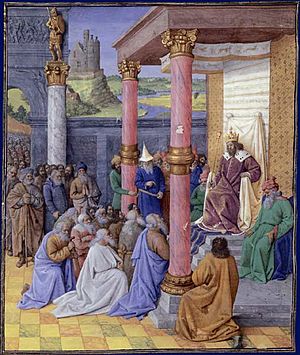
British historian Charles Freeman suggests that "In scope and extent his achievements [Cyrus] ranked far above that of the Macedonian king, Alexander, who was to demolish the [Achaemenid] empire in the 320s but fail to provide any stable alternative." Cyrus has been a personal hero to many people, including Thomas Jefferson, Mohammad Reza Pahlavi, and David Ben-Gurion.
The achievements of Cyrus the Great throughout antiquity are reflected in the way he is remembered today. His own nation, the Iranians, have regarded him as "The Father," the very title that had been used during the time of Cyrus himself, by the many nations that he conquered, as according to Xenophon:
And those who were subject to him, he treated with esteem and regard, as if they were his own children, while his subjects themselves respected Cyrus as their "Father" ... What other man but 'Cyrus', after having overturned an empire, ever died with the title of "The Father" from the people whom he had brought under his power? For it is plain fact that this is a name for one that bestows, rather than for one that takes away!
The Babylonians regarded him as "The Liberator".
The Book of Ezra narrates a story of the first return of exiles in the first year of Cyrus, in which Cyrus proclaims: "All the kingdoms of the earth hath the LORD, the God of heaven, given me; and He hath charged me to build Him a house in Jerusalem, which is in Judah."(Ezra 1:2)
Cyrus was distinguished equally as a statesman and as a soldier. Due in part to the political infrastructure he created, the Achaemenid Empire endured long after his death.
The rise of Persia under Cyrus's rule had a profound impact on the course of world history. Iranian philosophy, literature and religion all played dominant roles in world events for the next millennium. Despite the Islamic conquest of Persia in the 7th century AD by the Islamic Caliphate, Persia continued to exercise enormous influence in the Middle East during the Islamic Golden Age, and was particularly instrumental in the growth and expansion of Islam.
Many of the Iranian dynasties following the Achaemenid Empire and their kings saw themselves as the heirs to Cyrus the Great and have claimed to continue the line begun by Cyrus. However, there are different opinions among scholars whether this is also the case for the Sassanid Dynasty.
Alexander the Great was himself infatuated with and admired Cyrus the Great, from an early age reading Xenophon's Cyropaedia, which described Cyrus's heroism in battle and governance and his abilities as a king and a legislator. During his visit to Pasargadae he ordered Aristobulus to decorate the interior of the sepulchral chamber of Cyrus's tomb.
Cyrus's legacy has been felt even as far away as Iceland and colonial America. Many of the thinkers and rulers of Classical Antiquity as well as the Renaissance and Enlightenment era, and the forefathers of the United States of America sought inspiration from Cyrus the Great through works such as Cyropaedia. Thomas Jefferson, for example, owned two copies of Cyropaedia, one with parallel Greek and Latin translations on facing pages showing substantial Jefferson markings that signify the amount of influence the book has had on drafting the United States Declaration of Independence.
According to Professor Richard Nelson Frye, Cyrus – whose abilities as conqueror and administrator Frye says are attested by the longevity and vigor of the Achaemenid Empire – held an almost mythic role among the Persian people "similar to that of Romulus and Remus in Rome or Moses for the Israelites", with a story that "follows in many details the stories of hero and conquerors from elsewhere in the ancient world." Frye writes, "He became the epitome of the great qualities expected of a ruler in antiquity, and he assumed heroic features as a conqueror who was tolerant and magnanimous as well as brave and daring. His personality as seen by the Greeks influenced them and Alexander the Great, and, as the tradition was transmitted by the Romans, may be considered to influence our thinking even now."
Religion and philosophy
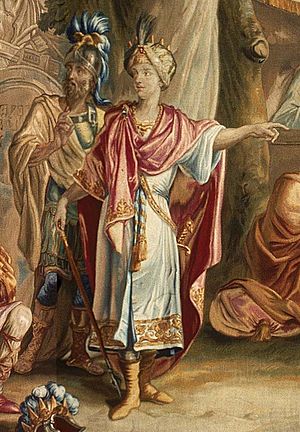
Though it is generally believed that Zarathushtra's teachings maintained influence on Cyrus's acts and policies, so far no clear evidence has been found to indicate that Cyrus practiced a specific religion. Pierre Briant wrote that given the poor information we have, "it seems quite reckless to try to reconstruct what the religion of Cyrus might have been."
The policies of Cyrus with respect to treatment of minority religions are documented in Babylonian texts as well as Jewish sources and the historians accounts. Cyrus had a general policy of religious tolerance throughout his vast empire. Whether this was a new policy or the continuation of policies followed by the Babylonians and Assyrians (as Lester Grabbe maintains) is disputed. He brought peace to the Babylonians and is said to have kept his army away from the temples and restored the statues of the Babylonian gods to their sanctuaries.
His treatment of the Jews during their exile in Babylon after Nebuchadnezzar II destroyed Jerusalem is reported in the Bible. The Jewish Bible's Ketuvim ends in Second Chronicles with the decree of Cyrus, which returned the exiles to the Promised Land from Babylon along with a commission to rebuild the temple.
Thus saith Cyrus, king of Persia: All the kingdoms of the earth hath the LORD, the God of heaven given me; and He hath charged me to build Him a house in Jerusalem, which is in Judah. Whosoever there is among you of all His people – the LORD, his God, be with him – let him go there. — (2 Chronicles 36:23)
This edict is also fully reproduced in the Book of Ezra.
In the first year of King Cyrus, Cyrus the king issued a decree: "Concerning the house of God at Jerusalem, let the temple, the place where sacrifices are offered, be rebuilt and let its foundations be retained, its height being 60 cubits and its width 60 cubits; with three layers of huge stones and one layer of timbers. And let the cost be paid from the royal treasury. Also let the gold and silver utensils of the house of God, which Nebuchadnezzar took from the temple in Jerusalem and brought to Babylon, be returned and brought to their places in the temple in Jerusalem; and you shall put them in the house of God." — (Ezra 6:3–5)
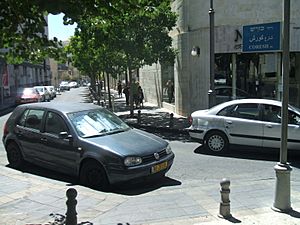
The Jews honored him as a dignified and righteous king. In one Biblical passage, Isaiah refers to him as Messiah (lit. "His anointed one") (Isaiah 45:1), making him the only gentile to be so referred. Elsewhere in Isaiah, God is described as saying, "I will raise up Cyrus in my righteousness: I will make all his ways straight. He will rebuild my city and set my exiles free, but not for a price or reward, says God Almighty." (Isaiah 45:13) As the text suggests, Cyrus did ultimately release the nation of Israel from its exile without compensation or tribute. These particular passages (Isaiah 40–55, often referred to as Deutero-Isaiah) are believed by most modern critical scholars to have been added by another author toward the end of the Babylonian exile (c. 536 BC).
Josephus, the first-century Jewish historian, relates the traditional view of the Jews regarding the prediction of Cyrus in Isaiah in his Antiquities of the Jews, book 11, chapter 1:
In the first year of the reign of Cyrus, which was the seventieth from the day that our people were removed out of their own land into Babylon, God commiserated the captivity and calamity of these poor people, according as he had foretold to them by Jeremiah the prophet, before the destruction of the city, that after they had served Nebuchadnezzar and his posterity, and after they had undergone that servitude seventy years, he would restore them again to the land of their fathers, and they should build their temple, and enjoy their ancient prosperity. And these things God did afford them; for he stirred up the mind of Cyrus, and made him write this throughout all Asia: "Thus saith Cyrus the king: Since God Almighty hath appointed me to be king of the habitable earth, I believe that he is that God which the nation of the Israelites worship; for indeed he foretold my name by the prophets, and that I should build him a house at Jerusalem, in the country of Judea." This was known to Cyrus by his reading the book which Isaiah left behind him of his prophecies; for this prophet said that God had spoken thus to him in a secret vision: "My will is, that Cyrus, whom I have appointed to be king over many and great nations, send back my people to their own land, and build my temple." This was foretold by Isaiah one hundred and forty years before the temple was demolished. Accordingly, when Cyrus read this, and admired the Divine power, an earnest desire and ambition seized upon him to fulfill what was so written; so he called for the most eminent Jews that were in Babylon, and said to them, that he gave them leave to go back to their own country, and to rebuild their city Jerusalem, and the temple of God, for that he would be their assistant, and that he would write to the rulers and governors that were in the neighborhood of their country of Judea, that they should contribute to them gold and silver for the building of the temple, and besides that, beasts for their sacrifices.

While Cyrus was praised in the Tanakh (Isaiah 45:1–6 and Ezra 1:1–11), there was Jewish criticism of him after he was lied to by the Cuthites, who wanted to halt the building of the Second Temple. They accused the Jews of conspiring to rebel, so Cyrus in turn stopped the construction, which would not be completed until 515 BC, during the reign of Darius I. According to the Bible it was King Artaxerxes who was convinced to stop the construction of the temple in Jerusalem. (Ezra 4:7–24)
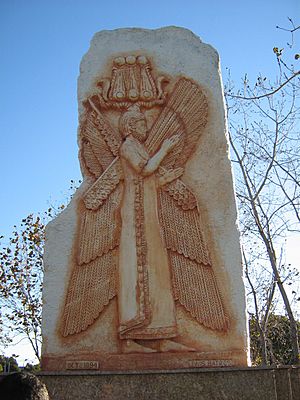
The historical nature of this decree has been challenged. Professor Lester L Grabbe argues that there was no decree but that there was a policy that allowed exiles to return to their homelands and rebuild their temples. He also argues that the archaeology suggests that the return was a "trickle", taking place over perhaps decades, resulting in a maximum population of perhaps 30,000. Philip R. Davies called the authenticity of the decree "dubious", citing Grabbe and adding that arguing against "the authenticity of Ezra 1.1–4 is J. Briend, in a paper given at the Institut Catholique de Paris on 15 December 1993, who denies that it resembles the form of an official document but reflects rather biblical prophetic idiom." Mary Joan Winn Leith believes that the decree in Ezra might be authentic and along with the Cylinder that Cyrus, like earlier rulers, was through these decrees trying to gain support from those who might be strategically important, particularly those close to Egypt which he wished to conquer. He also wrote that "appeals to Marduk in the cylinder and to Yahweh in the biblical decree demonstrate the Persian tendency to co-opt local religious and political traditions in the interest of imperial control."
Some modern Muslims have suggested that the Quranic figure of Dhu al-Qarnayn is a representation of Cyrus the Great, but the scholarly consensus is that he is a development of legends concerning Alexander the Great.
See also
 In Spanish: Ciro II el Grande para niños
In Spanish: Ciro II el Grande para niños


